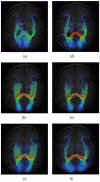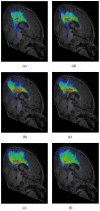PopTract: population-based tractography
- PMID: 21571607
- PMCID: PMC4855297
- DOI: 10.1109/TMI.2011.2154385
PopTract: population-based tractography
Abstract
White matter fiber tractography plays a key role in the in vivo understanding of brain circuitry. For tract-based comparison of a population of images, a common approach is to first generate an atlas by averaging, after spatial normalization, all images in the population, and then perform tractography using the constructed atlas. The reconstructed fiber trajectories form a common geometry onto which diffusion properties of each individual subject can be projected based on the corresponding locations in the subject native space. However, in the case of high angular resolution diffusion imaging (HARDI), where modeling fiber crossings is an important goal, the above-mentioned averaging method for generating an atlas results in significant error in the estimation of local fiber orientations and causes a major loss of fiber crossings. These limitatitons have significant impact on the accuracy of the reconstructed fiber trajectories and jeopardize subsequent tract-based analysis. As a remedy, we present in this paper a more effective means of performing tractography at a population level. Our method entails determining a bipolar Watson distribution at each voxel location based on information given by all images in the population, giving us not only the local principal orientations of the fiber pathways, but also confidence levels of how reliable these orientations are across subjects. The distribution field is then fed as an input to a probabilistic tractography framework for reconstructing a set of fiber trajectories that are consistent across all images in the population. We observe that the proposed method, called PopTract, results in significantly better preservation of fiber crossings, and hence yields better trajectory reconstruction in the atlas space.
© 2011 IEEE
Figures













References
-
- Alexander DC. Visualization and Processing of Tensor Fields. Springer; Berlin, Germany: 2006. pp. 83–106.
-
- Yap P-T, Wu G, Shen D. Human brain connectomics: Networks, techniques, and applications. IEEE Signal Process. Mag. 2010 Jul;27(4):131–134.
-
- Ciccarelli O, Catani M, Johansen-Berg H, Clark C, Thompson A. Diffusion-based tractography in neurological disorders: Concepts, applications, and future developments. Lancet Neurol. 2008;7(8):715–727. - PubMed
Publication types
MeSH terms
Grants and funding
- R01 EB008374/EB/NIBIB NIH HHS/United States
- R01 EB006733/EB/NIBIB NIH HHS/United States
- EB008374/EB/NIBIB NIH HHS/United States
- MH088520/MH/NIMH NIH HHS/United States
- R01 NS055754/NS/NINDS NIH HHS/United States
- EB009634/EB/NIBIB NIH HHS/United States
- EB006733/EB/NIBIB NIH HHS/United States
- NS055754/NS/NINDS NIH HHS/United States
- MH064065/MH/NIMH NIH HHS/United States
- P50 MH064065/MH/NIMH NIH HHS/United States
- HD05300/HD/NICHD NIH HHS/United States
- R01 EB009634/EB/NIBIB NIH HHS/United States
- RC1 MH088520/MH/NIMH NIH HHS/United States
- R01 HD053000/HD/NICHD NIH HHS/United States
LinkOut - more resources
Full Text Sources
Research Materials

